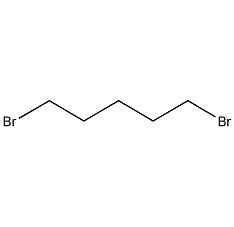
Structural formula
| Business number | 0331 |
|---|---|
| Molecular formula | C5H10Br2 |
| Molecular weight | 229.94 |
| label |
Pentamethyl dibromide, Pentamethylene dibromide, Pentylene dibromide, 1,5-dibromo-n-pentane, Pentamethylene dibromide, Pentane-1,5-dibromide, linear compound |
Numbering system
CAS number:111-24-0
MDL number:MFCD00000268
EINECS number:203-849-7
RTECS number:SA0320000
BRN number:1209245
PubChem number:24847812
Physical property data
1. Properties: colorless or light yellow liquid.
2. Density (g/mL, 20℃): 1.702
3. Relative density (20℃, 4℃): 1.7018
4. Melting point (ºC): -39.5
5. Boiling point (ºC, normal pressure): 222.3℃, 111~112℃ (2.67kPa)
6. Boiling point (ºC, 1.33kPa): 98.6
7. Refractive index: 1.7018
8. Flash point (ºC): 79
p>
9. Relative density (25℃, 4℃): 1.6948
10. Refractive index at room temperature (n20): 1.5126
11. Refractive index at room temperature (n25): 1.5103
12. Saturated vapor pressure (kPa, ºC): Undetermined
13. Heat of combustion ( KJ/mol): Undetermined
14. Critical temperature (ºC): Undetermined
15. Critical pressure (KPa): Undetermined
16. The logarithmic value of the oil-water (octanol/water) distribution coefficient: Undetermined
17. Explosion upper limit (%, V/V): Undetermined
18. Explosion lower limit (%, V/V): Undetermined
19. Solubility: Soluble in benzene and chloroform, insoluble in water. Has an aromatic smell.
Toxicological data
1. Mutagenicity: Salmonella mutation: 10umol/plate
E. coli DNA repair 10mg/plate
Ecological data
Is it harmful to water?
Molecular structure data
5. Molecular property data:
1. Molar refractive index: 40.67
2. Molar volume (cm3/mol): 137.4
3. Isotonic specific volume (90.2K): 335.3
4. Surface tension (dyne/cm): 35.4
5. Polarizability (10-24cm3): 16.12
Compute chemical data
1.Reference value for hydrophobic parameter calculation (XlogP): 2.8
2. Number of hydrogen bond donors: 0
3. Number of hydrogen bond acceptors: 0
4 .Number of rotatable chemical bonds: 4
5.Number of tautomers: None
6.Topological molecule polar surface area 0
7.Heavy atoms Number: 7
8. Surface charge: 0
9. Complexity: 25.3
10. Number of isotope atoms: 0
11. Determine the number of stereocenters of atoms: 0
12. Determine the number of stereocenters of atoms: 0
13. Determine the number of stereocenters of chemical bonds: 0
14. Number of uncertain chemical bond stereocenters: 0
15. Number of covalent bond units: 1
Properties and stability
Avoid contact with oxides and alkali.
Storage method
Store sealed in a cool, dry place. Ensure that the workspace has good ventilation facilities and is stored away from sources of fire and oxidants.
Synthesis method
Derived from ring-opening bromination of tetrahydropyran. In a 500ml flask, add 250g 48% hydrobromic acid; 75g concentrated sulfuric acid; 21.5g redistilled tetrahydropyran (86.5-87.5°C fraction). Install a reflux condenser and heat the brown mixture to reflux gently for 3 hours. After cooling to room temperature, separate the dibromide in the lower layer and wash it once with saturated sodium carbonate solution and once with water. Dry with anhydrous calcium chloride. Distill under reduced pressure and collect the 104-106°C (2.53kPa) fraction as the finished product. The yield is 46-47g and the yield is 80-82%.
Purpose
Used in organic synthesis.

 微信扫一扫打赏
微信扫一扫打赏

